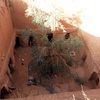Disclaimer
This entry contains information known to us from a variety of sources but may not include all the information currently available. Please be in touch if you notice any inadvertent mistakes in our presentation or have additional knowledge or sources to share. Thank you.
Archive
Jewish cave homes at Gharyan, Libya
In the Nafusa Mountains south of Tripoli, a thriving town flourished underground for hundreds of years. Since the sixteenth century, the Jews of Gharyan conducted daily life in cave homes dug twenty feet deep into the rock. The cave homes afforded protection from bandits and weather alike, and only in the early twentieth century did the town develop signifcant aboveground structures. While the vast majority of the town's Jews left in the 1950s and most of the cave homes are now abandoned, they remain a tourist attraction and a reminder of a unique culture of Libyan Jews.
Description
Cave Homes: There are hundreds of cave homes throughout the Nafusa mountains, with some accounts estimating that there may be close to a thousand in Gharyan alone. Most are several centuries old; one home in Gharyan that has been occupied by the same family for generations was first excavated in 1666.1 Dug more than six meters vertically into the rock, the homes generally consist of several caves around a central courtyard.2 Images of cave homes that have survived to the modern day show low-ceilinged rooms around 10 meters in length with smooth whitewashed walls draped with cloth; the doorways are irregularly-shaped arches that open onto square courtyards with steep walls. Typically, each cave was occupied by a different family, with the courtyard and cooking areas in smaller caves shared communally.3 Most of the cave homes in Gharyan have been abandoned, whether during the mass emigration to Israel in the 1950s or by families moving to aboveground houses. Some lie empty, while others have been converted to storage for goods or animals. The caves are a popular tourist attraction, and one family plans to excavate more caves and open a hotel.4
Jewish Community of Gharyan: A visitor in 1906 described Gharyan, a town located about fifty miles south of Tripoli in the Nafusa Mountains, as a mountain range populated by “cave dwellers.”5 The town’s Jewish families lived in caves and underground dwellings. Two nearby towns, Tigrinna and Banu Abbas, also had Jewish inhabitants, with Tigrinna having the largest Jewish population of the three.6 Jews from the Gharyan and Tigrinna area were noted for their strong social and cultural connections to their towns; according to one researcher, "the term 'Jew' alone had little meaning in the villages of North Africa" because local identity played such a strong role. The Jewish community of Gharyan, Libya, dates back to 1510, when Jewish refugees from Tripoli fled to the town after Spain captured Tripoli.7 The community continued to be a haven for Jews escaping persecution throughout the sixteenth century: a man named Hajjāj fled to Gharyan from Oran, Algeria, and eventually became the leader of Gharyan’s Jewish community.8 Gharyan’s Muslims and Jews revolted against the Ottomans in 1830, beginning a struggle that was only suppressed in 1855. The Ottoman regime pardoned the Jewish residents for their role in the uprising, and gave the Jewish community an exemption from military service that lasted until the Young Turk Revolution of 1908.9
Gharyan Jews in the 20th Century After the Italian occupation of Libya in 1911, the Gharyan area was a focal point for Arab resistance for more than a decade. The modern town of Gharyan came into being in the late 1920s with the construction of buildings aboveground. Between 1925 and 1928, the Italian regime established a police station, a medical clinic, and a post and telegraph office in the town, as well as several schools.10 New laws in the early 1940s resulted in thousands of Libyan Jews being imprisoned in forced labor camps, including Giado, Gharyan, and Tigrinna. Many Jews from Tripoli and Benghazi were interned at Gharyan due to a lack of space at Giado.11 Although the camps were liberated in 1943, a three-day pogrom against Libyan Jews in November 1945 further destablized the community. Most of the Jews of Gharyan emigrated to Israel in the 1950s, as part of an exodus that saw more than 80% of Libya's Jews leave the country.12
Sources
[1] Marie-Louise Gumuchian, "Going underground: Libya's unusual cave dwellings," Reuters, 1 July 2013. Accessed 18 January 2016. http://www.reuters.com/article/us-libya-caves-idUSBRE9600DQ20130701
[2] Nadia Mayen, "Libya renovates ancient 'cave houses'," Al Arabiya News, 31 May 2012. Accessed 18 January 2016. https://english.alarabiya.net/articles/2012/05/31/217783.html
[3] Gumuchian, "Going underground".
[4] Ibid.
[5] Maurice Roumani. "Gharian." Encyclopedia of Jews in the Islamic World. Brill Online, 2016. Accessed 18 January 2016. http://0-referenceworks.brillonline.com.luna.wellesley.edu/entries/encyclopedia-of-jews-in-the-islamic-world/gharian-SIM_0008440
[6] Ibid.
[7] Roumani. "Gharian".
[8] Ibid.
[9] Ibid.
[10] Brian McLaren, Architecture and Tourism in Italian Colonial Libya: An Ambivalent Modernism (Seattle: University of Washington Press, 2006), 27. Accessed 18 January 2016. https://books.google.com/books?id=_lrYlxdX7DIC
[11] Roumani. "Gharian."
[12] Ibid.


![Jewish Cave Homes, Courtyard [2] (Gharyan, Libya, n.d.)](https://cdn.filestackcontent.com/GyrQpO05Rcudim0sPgqE/convert?w=100&h=100&fit=crop)



